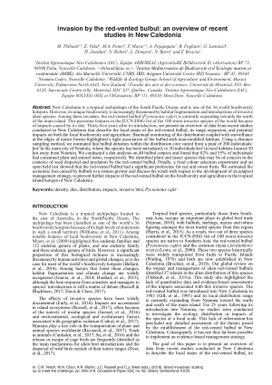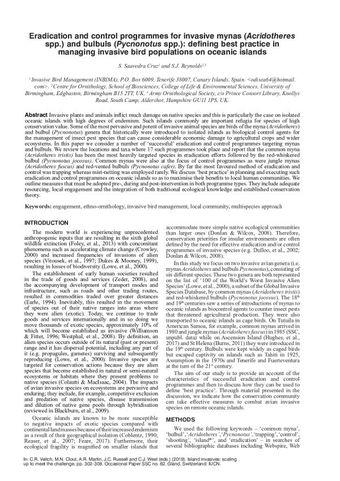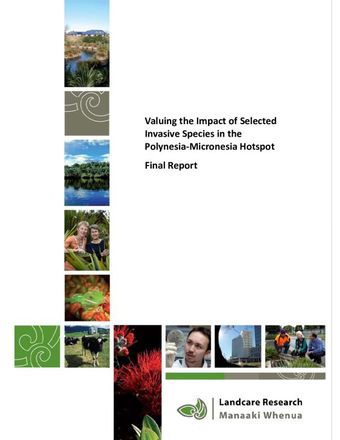Invasion by the red-vented bulbul: an overview of recent studies in New Caledonia
- Description:
- New Caledonia is a tropical archipelago of the South Pacific Ocean, and is one of the 36 world biodiversity hotspots. However, its unique biodiversity is increasingly threatened by habitat fragmentation and introductions of invasive alien species. Among these invaders, the red-vented bulbul (Pycnonotus cafer) is currently expanding towards the north of the main island. This passerine features in the IUCN-ISSG list of the 100 worst invasive species of the world because of impacts caused by its diet. Thirty-five years after its introduction, we present an overview of data from recent studies conducted in New Caledonia that describe the local status of the red-vented bulbul, its range expansion, and potential impacts on both the local biodiversity and agriculture. Biannual monitoring of the distribution coupled with surveillance at the edges of native forests highlighted a tight association of the bulbul with man-modified habitats. Using a distance sampling method, we estimated that bulbul densities within the distribution core varied from a peak of 200 individuals/km2 in the main city of Nouméa, where the species has been introduced, to 30 individuals/km2 in rural habitats located 50 km away from Nouméa. We conducted a diet analysis on 40 bulbul corpses and found that 82% and 55% of individuals had consumed plant and animal items, respectively. We identified plant and insect species that may be of concern in the contexts of seed dispersal and predation by the red-vented bulbul. Finally, a food colour selection experiment and an open field test showed that the red-vented bulbul had a significant preference for red and sweet fruits. We estimated the economic loss caused by bulbuls to a tomato grower and discuss the result with respect to the development of an adapted management strategy, to prevent further impacts of the red-vented bulbul on the biodiversity and agriculture in the tropical island hotspot of New Caledonia.
- Display date:
- 2019
- Collections:
- Secretariat of the Pacific Regional Environment Programme (SPREP)
- Publisher:
- International Union for Nature Conservation (IUCN)
- Content partner:
- Secretariat of the Pacific Regional Environment Programme (SPREP)
- Availability:
- Not specified
-
Copyright status: All rights reservedFind out more about what you are able to do with this itemThis item is all rights reserved, with means you'll have to get permission from Secretariat of the Pacific Regional Environment Programme (SPREP) before using it. For more information, please see our use and reuse page.What can I do with this item?Non-infringing useNZ copyright law does not prevent every use of a copyright work, and this item may be hosted by an international institute or organisation. You should consider what you can and cannot do with a copyright work.No sharingYou may not copy and/or share this item with others without further permission. This includes posting it on your blog, using it in a presentation, or any other public use.No modifyingYou are not allowed to adapt or remix this item into any other works.No commercial useYou may not use this item commercially.
Related items
Welcome and warm Pasifik greetings
The information on this site has been gathered from our content partners.
The names, terms, and labels that we present on the site may contain images or voices of deceased persons and may also reflect the bias, norms, and perspective of the period of time in which they were created. We accept that these may not be appropriate today.
If you have any concerns or questions about an item, please contact us.


